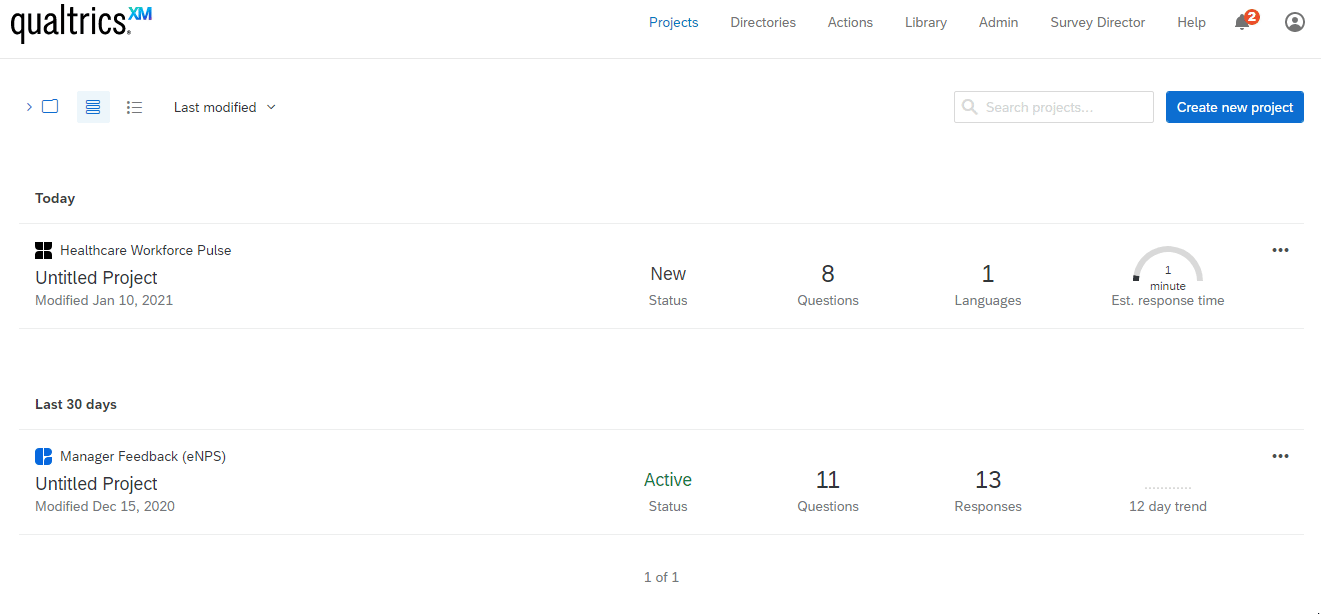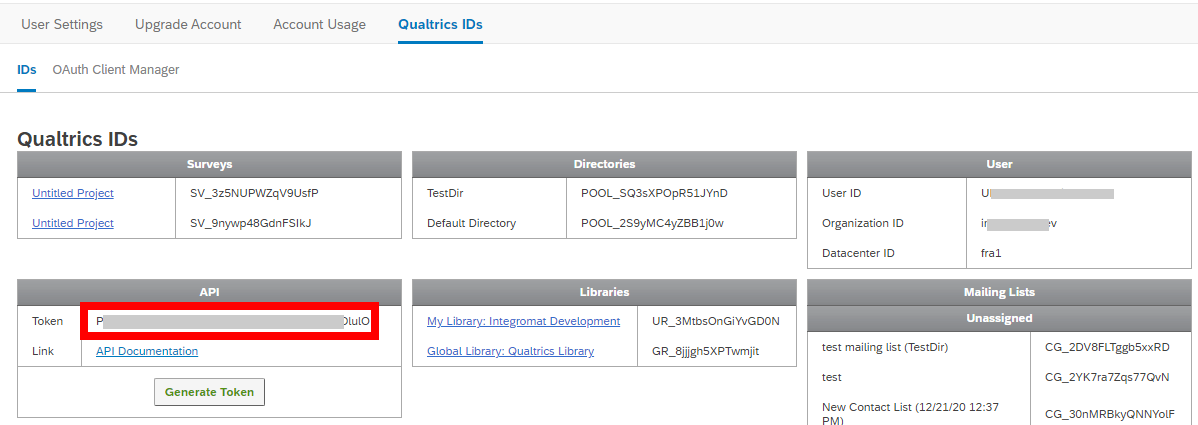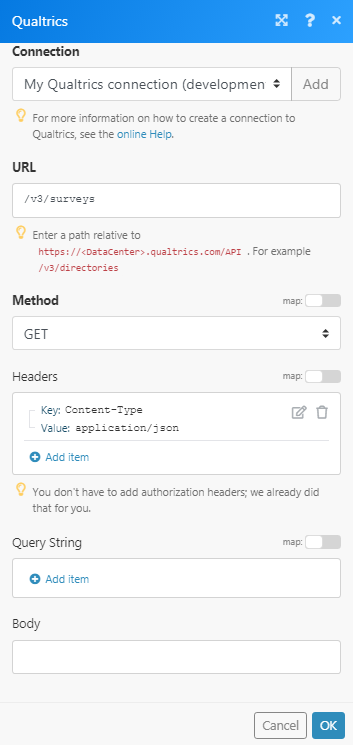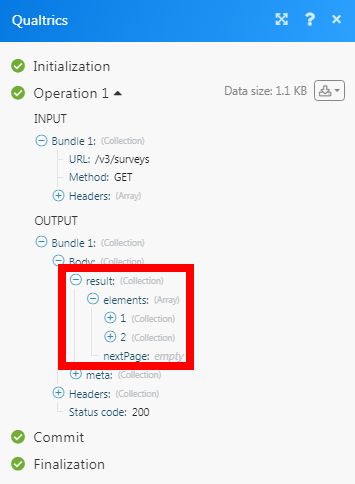| Active with remarks |
|---|
| This application needs additional settings. Please follow the documentation below to create your own connectionUnique, active service acces point to a network. There are different types of connections (API key, Oauth…). More. |
The Qualtrics modulesThe module is an application or tool within the Boost.space system. The entire system is built on this concept of modularity. (module - Contacts) More allow you to watch, create, list, retrieve, and delete the directory contact, and survey distributions in your Qualtrics account.
Prerequisites
-
A Qualtrics account
In order to use Qualtrics with Boost.spaceCentralization and synchronization platform, where you can organize and manage your data. More IntegratorPart of the Boost.space system, where you can create your connections and automate your processes. More, it is necessary to have a Qualtrics account. If you do not have one, you can create a Qualtrics account at qualtrics.com.
![[Note]](https://docs.boost.space/wp-content/themes/bsdocs/docs-parser/HTML/css/image/note.png) |
Note |
|---|---|
|
The moduleThe module is an application or tool within the Boost.space system. The entire system is built on this concept of modularity. (module - Contacts) More dialog fields that are displayed in bold (in the Boost.space Integrator scenarioA specific connection between applications in which data can be transferred. Two types of scenarios: active/inactive. More, not in this documentation article) are mandatory! |
To connect your Qualtrics account to Boost.space Integrator you need to obtain the API Key from your Qualtrics account and insert it in the Create a connection dialog in the Boost.space Integrator module.
1. Log in to your Qualtrics account.
2. Click Your Profile Icon > Account Settings > Qualtrics IDs.

3. Copy the API tokenThe API token is a multi-digit code that allows a user to authenticate with cloud applications. More to your clipboard.

4. Go to Boost.space Integrator and open the Qualtrics module’s Create a connection dialog.

5. In the Connection name field, enter a name for the connection.
6. In the Data Center ID field, enter your account’s data center ID. You can find it in the Your Profile Icon > Account Settings > Qualtrics IDs.
7. In the API Key field, enter the API tokenThe API token is a multi-digit code that allows a user to authenticate with cloud applications. More copied in step 3, and click Continue.
The connection has been established.
Lists all directory contacts.
|
Connection |
|
|
Directory ID |
Select the Directory ID whose contact details you want to retrieve. |
|
Limit |
Set the maximum number of contacts Boost.space Integrator should return during one scenario execution cycleA cycle is the operation and commit/rollback phases of scenario execution. A scenario may have one or more cycles (one is the default).. |
Creates a single contact in a specified directory.
|
Connection |
|
|
Directory ID |
Select the Directory ID to which you want to add the contact. |
|
First Name |
Enter the contact’s first name. |
|
Last Name |
Enter the contact’s last name. |
|
|
Enter the contact’s email address. |
|
Phone |
Enter the contact’s phone number. |
|
External Reference |
Enter the external reference details of the contact. |
|
Embedded Data |
Add the itemsItems are rows in records (order/request/invoice/purchase...) you want to embed to the contact by entering its name and value. For example, contact’s address. |
|
Language |
Enter the contact’s preferred language. |
|
Unsubscribed |
Select whether the contact is unsubscribed. |
Returns information about the selected directory contact.
|
Connection |
|
|
Directory ID |
Select the Directory ID whose contact details you want to retrieve. |
|
Contact ID |
Select the Contact ID whose details you want to retrieve. |
Updates an existing directory contact.
|
Connection |
|
|
Directory ID |
Select the Directory ID whose contact details you want to update. |
|
Contact ID |
Select the Contact ID whose details you want to update. |
|
First Name |
Enter the contact’s first name. |
|
Last Name |
Enter the contact’s last name. |
|
|
Enter the contact’s email address. |
|
Phone |
Enter the contact’s phone number. |
|
External Reference |
Enter the external reference details of the contact. |
|
Embedded Data |
Add the items you want to embed to the contact by entering its name and value. For example, |
|
Language |
Enter the contact’s preferred language. |
|
Unsubscribed |
Select whether the contact is unsubscribed. |
Deletes an existing directory contact.
|
Connection |
|
|
Directory ID |
Select the Directory ID whose contact details you want to retrieve. |
|
Contact ID |
Select the Contact ID whose details you want to retrieve. |
Creates a new survey distribution via SMS.
|
Connection |
|
|
Send Date |
Enter the date and time to send the SMS. See the list of supported date and time formats. |
|
Method |
Select the distribution method:
|
|
Directory ID |
Select the Directory ID to whose contacts you want to send the SMS. |
|
Mailing List ID |
Select the Mailing List ID to which you want to send the SMS. You can provide either |
|
Contact ID |
Select the Contact ID to which you want to send the SMS. You can set only one of these fields: |
|
Sample ID |
Select the Contact ID to which you want to send the SMS. You can set only one of these fields: |
|
Transaction Batch ID |
Select the Contact ID to which you want to send the SMS. |
|
Survey ID |
Select the Survey ID you want to distribute. |
|
Parent Distribution ID |
Select the Parent Distribution ID to which this survey distribution belongs to. |
|
Distribution Name |
Enter a name for the distribution. |
|
Library ID |
Select the Library ID to which the message belongs to. |
|
Message ID |
Select the Message-ID you want to distribute. |
|
Message Text |
Enter the message text you want to distribute. |
Distributes a survey via email.
|
Connection |
|
|
From Email |
Enter the email address from which you want to distribute the survey. |
|
From Name |
Enter the name that appears in the From field of the email. |
|
Subject |
Enter the email’s subject line. |
|
Send Date |
Enter the date and time to send the SMS. See the list of supported date and time formats. |
|
Survey ID |
Select the Survey ID you want to distribute through email. |
|
Library ID |
Select the Library ID to which the message belongs to. |
|
Message ID |
Select the Message-ID you want to send in the email. You can provide either |
|
Message Text |
Enter the message text you want to add to the email. You can provide either |
|
Directory ID |
Select the Directory ID to whose contacts you want to send the email. |
|
Mailing List ID |
Select the Mailing List ID to which you want to send the email. You can provide either |
|
Transaction Batch ID |
Select the Contact ID to which you want to send the SMS. Provide either |
|
Contact ID |
Select the Contact ID to which you want to send the email. |
|
Reply to Email |
Enter the email address to which recipients can reply to. |
|
Expiration Date |
Enter the date when the survey expires. See the list of supported date and time formats. |
Performs an arbitrary authorized API call.
|
Connection |
||||
|
URL |
Enter a path relative to
|
|||
|
Method |
Select the HTTP method you want to use: GET to retrieve information for an entry. POST to create a new entry. PUT to update/replace an existing entry. PATCH to make a partial entry update. DELETE to delete an entry. |
|||
|
Headers |
Enter the desired request headers. You don’t have to add authorization headers; we already did that for you. |
|||
|
Query String |
Enter the request query string. |
|||
|
Body |
Enter the body content for your API call. |
The following API call returns all the surveys from your Qualtrics account:
URL: /v3/surveys
Method: GET

Matches of the search can be found in the module’s Output under BundleA bundle is a chunk of data and the basic unit for use with modules. A bundle consists of items, similar to how a bag may contain separate, individual items. More > Body> result > elements. In our example, 2 surveys were returned:

TriggersEvery scenario has a trigger, an event that starts your scenario. A scenario must have a trigger. There can only be one trigger for each scenario. When you create a new scenario, the first module you choose is your trigger for that scenario. Create a trigger by clicking on the empty module of a newly created scenario or moving the... when a new response is created for the selected survey.
![[Note]](https://docs.boost.space/wp-content/themes/bsdocs/docs-parser/HTML/css/image/note.png) |
Note |
|---|---|
|
You do not have to add the webhooksA webhook is a way for an app to send real-time information to a specific URL in response to certain events or triggers. in the Qualtrics as it is automatically done for you once you add and save an instant triggerEvery scenario has a trigger, an event that starts your scenario. A scenario must have a trigger. There can only be one trigger for each scenario. When you create a new scenario, the first module you choose is your trigger for that scenario. Create a trigger by clicking on the empty module of a newly created scenario or moving the... module to your scenario. |
|
WebhookA webhook is a way for an app to send real-time information to a specific URL in response to certain events or triggers. Name |
Enter a name for the webhook. |
|
Connection |
|
|
Survey ID |
Select the Survey ID whose new responses you want to watch. |
